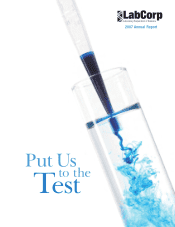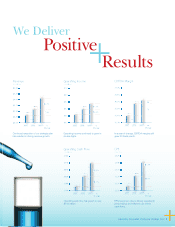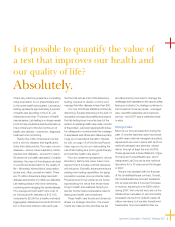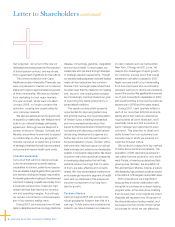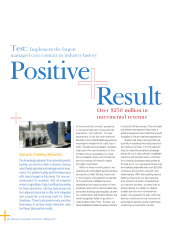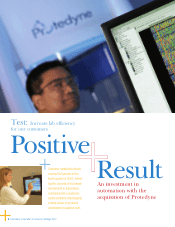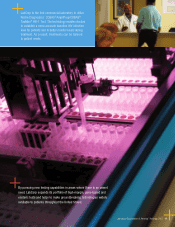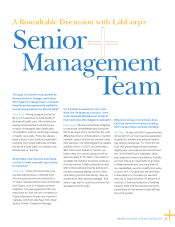LabCorp 2007 Annual Report Download - page 5
Download and view the complete annual report
Please find page 5 of the 2007 LabCorp annual report below. You can navigate through the pages in the report by either clicking on the pages listed below, or by using the keyword search tool below to find specific information within the annual report.
Laboratory Corporation of America® Holdings 2007 3
This is why LabCorp presents a compelling
value proposition to our shareholders and
to the entire health care system. Laboratory
testing represents approximately 4 percent
of health care spending in the U.S., yet
infl uences more than 70 percent of health
care decisions. Lab testing is no longer merely
a tool to help physicians decide what ails us;
it is a critical part of the full continuum of
health care delivery – prevention, diagnosis,
treatment and monitoring.
Twenty-fi ve million Americans now live
with a chronic disease that signifi cantly
limits their daily activity. The major chronic
diseases – cancer, lower respiratory, cardio-
vascular and diabetes – account for nearly
80 percent of our health care spend. Consider
diabetes: the onset of this disease can lead
to a profound deterioration in the quality of
life – blindness, kidney failure, amputation,
stroke and, often, premature death. There
are 15 million Americans diagnosed with
diabetes and another 43 million pre-diabetics.
Lab testing plays a vital role in detecting,
monitoring and managing this terrible disease.
The average annual health care cost of
an individual with diabetes is $13,243,
compared to $2,546 for a healthy individual.
Aggregated, diabetes accounts for $132 bil-
lion in direct and indirect costs each year.
Yet the total annual cost of the laboratory
testing required to detect, monitor and
manage this killer disease is less than $50.
I, for one, fi nd these statistics profoundly
disturbing. Equally disturbing is the lack of
recognition among policymakers and payors
that lab testing is an important part of the
solution to spiraling health care costs, not part
of the problem. LabCorp has joined with indus-
try colleagues to communicate this message
to lawmakers and others who infl uence policy.
I urge you to read about this effort, Results
for Life, on page 15 of this Annual Report.
I also urge you to join us in advocating the
use of lab testing as a tool to guide therapy
and optimize health care spend.
From an investment perspective, clinical
laboratory testing has never been more
relevant than it is today, and this relevance
will only grow. Scientifi c advancements are
yielding new testing capabilities. An aging
population requires more and better tests.
Physicians and their patients are better
appreciating the value that these tests
bring to health and wellness. Simply put,
secular trends make a persuasive case for
testing as a health care investment.
These health care trends and dynamics
shape our strategic direction. The invest-
ments we make and the priorities we set
are infl uenced by how best to manage the
challenges and capitalize on the opportunities
facing our industry. Our strategy continues to
be focused on three key areas – managed
care, scientifi c leadership and customer
service – and 2007 was a watershed year
in each.
Managed Care
Much of our time and attention during the
past 12 months has been spent recontract-
ing with major national managed care plans.
Agreements are now in place with all of our
national managed care partners, except
Aetna, through at least the end of 2009.
These agreements include Wellpoint, Cigna,
Humana and UnitedHealthcare, which
designated LabCorp as its sole national
laboratory for a 10-year period that began
in 2007.
We are very pleased with the fi rst year
of the UnitedHealthcare contract. Overall,
the UnitedHealthcare contract translated
into an approximate 6.6 percent increase
in revenue, equating to over $250 million
during 2007. Not only did we build out the
infrastructure necessary to accommodate
increased volume from United’s nearly 28
million members, but we also transitioned
business far more successfully than we
Is it possible to quantify the value of
a test that improves our health and
our quality of life?
Absolutely.

